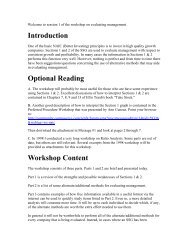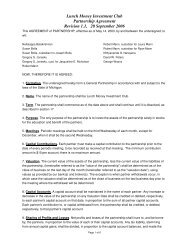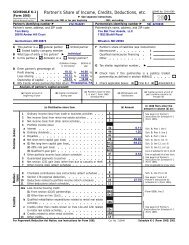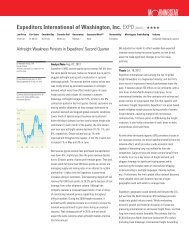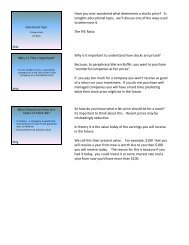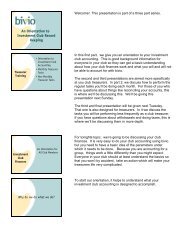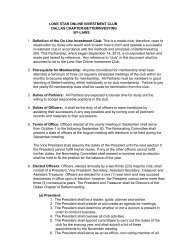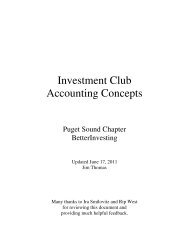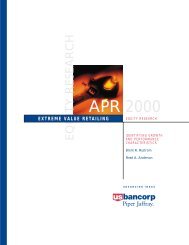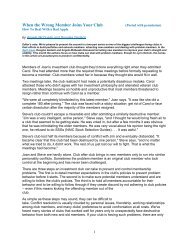Portfolio Management Workshop with Ellis Traub - Bivio
Portfolio Management Workshop with Ellis Traub - Bivio
Portfolio Management Workshop with Ellis Traub - Bivio
Create successful ePaper yourself
Turn your PDF publications into a flip-book with our unique Google optimized e-Paper software.
<strong>Portfolio</strong> <strong>Management</strong> <strong>Workshop</strong><br />
Session #1: <strong>Portfolio</strong> <strong>Management</strong> – What does it really mean?<br />
INTRODUCTION<br />
Most NAIC education deals <strong>with</strong> the acquisition of stocks. Likewise, clubs and individual<br />
investors also spend the majority of their time on purchase decisions. The Stock Selection<br />
Guide (SSG) and Stock Comparison Guide are the most frequently used tools and they<br />
are the most frequently taught.<br />
I believe that NAIC needs to begin to stress what happens after the fun of picking and<br />
buying is over. Councils need to begin to focus on <strong>Portfolio</strong> <strong>Management</strong>.<br />
GOALS<br />
NAIC investors set a goal to build a portfolio that doubles in value every five years. This<br />
means that a portfolio's growth has to average around 15% annual growth. It doesn't<br />
mean that every stock in a portfolio has to perform like that. It means that a portfolio has<br />
to average that kind of growth.<br />
PORTFOLIO MANAGEMENT<br />
<strong>Portfolio</strong> <strong>Management</strong> essentially consists of the activities that help investors reach<br />
desired investment goals. It is the art of optimizing holdings and increasing the value of a<br />
portfolio. And it takes some common sense and diligence to do it successfully. At times,<br />
it even takes a little courage.<br />
This workshop will discuss the process and the tools at your disposal to make the most of<br />
your investments. It may also suggest some answers to some of the questions you may<br />
have about when or why you should sell your stocks and what you might want to do in<br />
today's market.<br />
TWO PLATOON GAME -- DEFENSE<br />
<strong>Portfolio</strong> <strong>Management</strong>, like football, is a two platoon game -- offense and defense.<br />
For defense, you are primarily interested in preventing damage to a portfolio. The<br />
inexorable Rule of Five anticipates the damage.<br />
RULE OF FIVE<br />
For every five stocks you select, no matter how diligently and conservatively you do your<br />
homework, one stock will do better than expected. Three stocks will do about as<br />
expected, and one will go down the proverbial tubes.
You want to catch those bad boys before they have a chance to do any damage.<br />
DIVERSIFICATION<br />
The second element of defensive portfolio management deals <strong>with</strong> diversification. One of<br />
the four NAIC principles tells you to diversify. The reason for this is, obviously, not to<br />
have all of your eggs in one basket. Exercise diligence to make sure that you don't buy<br />
stocks that overpopulate any one industry sector or business.<br />
There is always the prospect that one or another of your investments will do very well,<br />
relatively speaking. It will balloon that investment and an inordinate amount of the<br />
portfolio's dollars will represent that one stock. We will talk about this issue later.<br />
OFFENSE<br />
Taking the offensive involves the process of analyzing a portfolio for opportunity. NAIC<br />
counsels that, under certain circumstances, you should look to replace stocks <strong>with</strong> others<br />
of equal or better quality and <strong>with</strong> a better potential for return.<br />
In today's high-strung market, you find that many of the most favored companies have<br />
reached such a high price that the risk of loss far outweighs the potential reward. How<br />
much is too much? And what should you do in such a case?<br />
The diligent application of both defense and offense will help each of you meet the goal<br />
to double a portfolio's value every five years.<br />
PORTFOLIO MANAGEMENT TOOLS<br />
NAIC provides an excellent assortment of tools <strong>with</strong> which to perform portfolio<br />
management tasks.<br />
The foremost, and by far the most important, tool is the Stock Selection Guide. Armed<br />
<strong>with</strong> the SSG, it is possible to do an excellent job on both defense and offense. For many<br />
years, NAIC members used the manual SSG alone to accomplish the tasks that we'll talk<br />
about over the next few days.<br />
The additional forms are all relatively recent additions to the NAIC repertoire. They are<br />
the PERT (<strong>Portfolio</strong> Evaluation Review Technique), <strong>Portfolio</strong> <strong>Management</strong> Guide, and<br />
the <strong>Portfolio</strong> Trend Report. In addition, the PERT has two associated feeder forms, PERT<br />
Worksheet-A and PERT Worksheet-B.<br />
I-CLUB-LIST WORKSHOP PORTFOLIO<br />
For purposes of this workshop, assume that you have a small portfolio. It consists of:<br />
100 Cisco (CSCO)
100 Forest Labs (FRX)<br />
100 Merck (MRK)<br />
100 Biomet (BMET)<br />
100<br />
Clayton Homes<br />
(CMH)<br />
These companies illustrate most of the issues that we will discuss in next few days.<br />
Session #2: The PERT -- First Line of Defense<br />
FUNDAMENTAL PERFORMANCE<br />
As <strong>with</strong> the ball game metaphor, defense involves vigilance -- protecting ourselves from<br />
harm.<br />
Fundamental performance is the first and the most critical concern in a defensive plan.<br />
Unlike technical analysts who watch for telltale price movement to make buy or sell<br />
decisions, NAIC investors monitor the operations of the companies whose stocks they<br />
own.<br />
You purchase stocks for the same reason that stock was first issued centuries ago -- to<br />
participate in the earnings of the enterprise for the long term, not simply to buy and sell<br />
for profit. For that reason, you're interested in watching just how well those companies<br />
operate and generate their earnings.<br />
UPDATE SSGs<br />
First, update the data and prices for all of the Stock Selection Guides (SSG) in a portfolio.<br />
Toolkit Pro 3.1.1 takes you from each company screen to Web site sources for both the<br />
price updates and the Edgar SEC filings.<br />
REVIEW ASSUMPTIONS<br />
Second, quickly review each SSG to make sure that the initial assumptions are correct<br />
and that you still agree <strong>with</strong> your original judgment. Be sure to modify the previous<br />
judgments if conditions have changed to warrant it. Use your current judgments in your<br />
portfolio review.<br />
PERT: DEFENSIVE ELEMENTS<br />
Most of what needs to be done may be accomplished <strong>with</strong> the Stock Selection Guide if it<br />
is all that you have. Most of the information that we will discuss comes from the SSG. It's<br />
certainly the first place that a problem will show up and can be a defensive scout.
However, the ideal place to look for trouble is in the PERT (<strong>Portfolio</strong> Evaluation<br />
Review Technique) form after you have updated the SSGs and saved them.<br />
The PERT is a collection of the relevant data from all of the SSGs in a portfolio and it is<br />
the best place to spot problem companies. It's your first line of defense. In the Toolkit,<br />
activate the PERT to display the NAIC PERT form on the screen.<br />
The most important elements of defense are found on the left side of the form starting<br />
<strong>with</strong> the fifth column. These are the four columns labeled EPS, Sales, Pre-tax Profit, and<br />
Trailing 12-month EPS.<br />
Here's where you find the actual quarterly data for the current quarter and the same<br />
quarter a year ago, the percent change (growth rate), and, in the case of Pre-Tax Profit,<br />
the Profit Margin (%Pre-tax Profit on Sales).
With Toolkit, click on the label at the top of the form to rank the stocks from the worst to<br />
the best performers. (The illustration is ranked by Pre-Tax Profit.)<br />
COMPARISONS<br />
Compare each of these growth rates <strong>with</strong> your expectation of the company's growth when<br />
you first bought it. Estimated earnings growth serves as the best measure of expected<br />
company growth and is found in the 13th column from the left.<br />
Sales<br />
Look first at sales growth because it is the most stable statistic and, should there be any<br />
serious decline in the growth from the previous year, its cause would likely not be trivial.<br />
Even if growth rates aren't negative, you still want to see growth close to what you<br />
anticipated the company's growth would be.<br />
Pre-Tax Profit<br />
Next in importance is probably Pre-Tax Profit -- but only if you have access to the actual<br />
figures. If you subscribe to the electronic data sources, you will have them. If not, you<br />
can quickly obtain them by clicking on the Toolkit's Web access button at the top of the<br />
screen as you update and review each SSG. A pull-down menu takes you directly to<br />
FreeEdgar for the company you are working <strong>with</strong>.<br />
Again, compare the percent change <strong>with</strong> your earnings growth estimate. Disappointments<br />
in PTP growth are critical because you can see them before they show up on the bottom<br />
line. It's not easy for a company to hide changes in Pre-Tax Profit, but they can tinker<br />
<strong>with</strong> the tax rate or the number of shares outstanding and keep disappointing numbers<br />
from reaching the earnings line until the end of the fiscal year.<br />
Catching problems at this point, especially if they're serious problems, can save you lots<br />
of money because you can divest yourself of the poor performers before the rest of the<br />
world reacts to a bad earnings report. A significant disappointment in PTP is important to<br />
explore and make sure that you know what caused it. Usually a call to the Investor<br />
Relations person will provide you <strong>with</strong> a reason and you'll have to decide on its gravity.<br />
Earnings<br />
Finally, look at the earnings -- preferably the 12-month trailing earnings -- because this<br />
will dampen out the occasional poor quarter and smooth out the volatility of simple<br />
quarterly data. If earnings growth is lagging, then it may already be too late to do<br />
anything except to cut your losses and get out.<br />
Benchmark: Growth Rate in EPS
The PERT "Est Growth Rate EPS" is the growth rate that is necessary to meet the<br />
expectations for the return on the investment. In a perfect world <strong>with</strong> constant profit<br />
margins, taxes, and shares outstanding, the sales, pre-tax profit, and earnings will all<br />
grow at the same rate and as fast as expected. If earnings growth slows appreciably below<br />
expectations, the rate of the return on the investment will fall short of the goal. Investors<br />
need to look for the signs that this might happen.<br />
Since the world isn't perfect, look at each of the fundamental values independently in<br />
order to learn something from each one. Sales lags are not trivial because it takes<br />
somewhat of a catastrophe to turn that type of growth downwards. If sales growth is<br />
normal, but we find pre-tax profit flagging, we are looking at declining profit margins<br />
and can see that the problem is the way that management is handling expenses. If sales<br />
and PTP are doing fine, but earnings per share is slowing, look at tax rates and/or an<br />
increase in shares outstanding as the cause of the problem. However, that is less<br />
worrisome because they are probably not long-term problems. And so on.<br />
Look out, though! You shouldn't simply sell when there is a single bad quarter. You will<br />
want to look a little further. We'll talk about when and why to sell in the next session.<br />
A question on profit margins versus pre-tax profit led to this additional explanation<br />
from <strong>Ellis</strong>:<br />
When we look at profit margins, we certainly hope to find a steady or up trend and not a<br />
down trend, quarter to quarter. We never make an effort to quantify a trend. If there's no<br />
growth in profit margins, that's just fine. It may well mean that the company is operating<br />
at near-peak efficiency and can't do very much to cut costs <strong>with</strong>out it becoming counterproductive.<br />
For example, downsizing a company produces a short term increase in profit<br />
margin but costs a company dearly in the long run.<br />
If there's an up-trend, that's okay too. It probably means that there was a need for<br />
efficiency and management is doing something about it.<br />
Downtrends are bad news, though, because they mean that management's ability to<br />
contain costs is diminishing. <strong>Management</strong> may be becoming extravagant. However, when<br />
profit margins don't grow or they decrease, we don't seek to quantify a trend.<br />
Sales, pre-tax profit, and EPS are quite different. Here we are looking for growth and<br />
we do quantify that growth.<br />
Session #3: The Trend Report (Investor's Toolkit): A Call to Action
WHEN TO SELL<br />
<strong>Portfolio</strong> <strong>Management</strong>, because you already own the stocks and purchased them to hold<br />
for the long term, implies that there is either a time or a cause for selling them (other than<br />
when you want or need the money). Therefore, let's talk about selling stocks.<br />
The rules that cover this, cited in the NAIC Official Guide: Starting and Running a<br />
Profitable Investment Club, instruct you:<br />
NEVER SELL . . . unless the company:<br />
• Has had an adverse management change.<br />
• Has declining profit margins.<br />
• Has had a deteriorating corporate financial condition.<br />
• Has been beset by effective competition.<br />
• Has relied on a single product that is becoming obsolete.<br />
• Has changed for the worse due to economic conditions.<br />
• Has proven to be cyclical.<br />
• Has upset the balance by company size in your portfolio.<br />
All but the last of these items represent conditions that deal <strong>with</strong> the fundamentals of the<br />
company over the long term. And the list isn't restricted only to those specific items.<br />
There are many reasons why a company may falter.<br />
(The last deals <strong>with</strong> diversification and falls into another defensive category that we'll<br />
discuss later.)<br />
TROUBLE SIGNS<br />
Look for signs of these kinds of problems in the PERT report. However, you should<br />
realize that the PERT does not display more than a single quarter. Like security guards<br />
viewing a bank of TV monitors in a large building, you should look at a portfolio for<br />
anything suspicious. If you find something, it's a call to investigate, not necessarily to<br />
sell. You have additional tools for your investigation.<br />
The PERT Report excerpt shown in Session #2 is ranked by Pre-Tax Profit. Forest Labs,<br />
the worst performer, shows that sales are doing just fine as might be expected. As we<br />
said, it is difficult to make a radical change in that statistic in a single quarter. However,<br />
the Pre-Tax Profits declined 35.3% over the year before; and earnings have declined<br />
36.8%. There is no data for Trailing 12-month earnings since earnings last year was<br />
negative and percent change can't be calculated!
This is certainly a warning sign. Had you been doing PERT on a regular basis, you would<br />
probably have seen more reason to be alarmed - and much sooner.<br />
The next step is to see if this decline in fundamentals has only just begun or is it<br />
something that has gone on for more than just this quarter. I believe that one bad quarter<br />
may be just a quirk. Two or more quarters are significant and require action.<br />
PORTFOLIO TREND REPORT<br />
If you had retained the PERT from the previous quarter, you would be able to compare it<br />
<strong>with</strong> the current edition and see if there are two disappointing quarters. If you have the<br />
Toolkit Pro 3.1.1 (previously referred to as the Complete Toolkit), the next step is to click<br />
on the button at the top of the PERT to bring up the Trend Report, so called because it<br />
reveals the "trend of the trends."
Look at the percent change in the same four columns, Sales, Pre-tax Profit, EPS, and<br />
Trailing 12-month EPS. However, the data has been removed and there are two similar<br />
lines of data for each company. The top line represents the same information that you just<br />
looked at in the PERT. The line beneath represents the percent change between the<br />
previous quarter and its counterpart in the year before. In other words, you are looking at<br />
the result of last quarter's PERT. Now you can see two quarters in a row and the growth<br />
for each.<br />
Again, you wish to compare these growth rates <strong>with</strong> your expectation (estimated earnings<br />
growth). In the Trend report, it is placed in the column adjacent to the four fundamentals<br />
columns for convenience, labeled "Est.E/S Growth."<br />
If you see two quarters that are satisfactory, you are happy <strong>with</strong> that company for the<br />
moment. That is true <strong>with</strong> all of the companies save Forest Laboratories (NYSE: FRX).
If you see that the previous quarter was disappointing but the most recent quarter is<br />
satisfactory, you can say that the company had a transient problem but appears to be<br />
coming back on track. If the current quarter was disappointing but the previous quarter<br />
was good, you might want to explore to find out what caused the slump; but you'll<br />
probably go another quarter to see what the company will do.<br />
However, if both last quarter and the current quarter are down, then you need to act - and<br />
act right away. Do you sell? Not yet. A call to action merely means that, when you see<br />
two quarters in a row that are substantially beneath your expectations, you should find<br />
out why. You need to determine if the problem is long term or transient.<br />
In the case of Forest, it appears that last quarter was anomalous, what <strong>with</strong> earnings<br />
growth exceeding 700%. This has to make us curious. For earnings to increase that much,<br />
it must mean that the data on which that growth was based must be extraordinarily poor.<br />
That demands our attention.<br />
The next step is to look at this quarterly data in more detail. We'll talk about that in the<br />
next session.<br />
Session #4: PERT-A and the PMG -- Looking at the Details<br />
A look at the PERT aroused our suspicions about Forest Labs. The company had a<br />
disappointing quarter compared <strong>with</strong> the same quarter the year before. On the Trend<br />
Report, suspicions were further aroused by a 700% growth in earnings for the previous<br />
quarter over its counterpart the year before. Therefore, you will want to look at what is<br />
going on <strong>with</strong> Forest in greater detail. The PERT Worksheet-A lets you do this.<br />
PERT WORKSHEET A<br />
If you use the Toolkit Pro, you will find that the data is automatically recorded each time<br />
you update the quarterly data for the SSG.<br />
Within the Trend Report (or the PERT, for that matter), double-click on the line<br />
corresponding to the company which interests you to drill down to the details behind that<br />
data and view its PERT-A Report. Here you can see the quarterly progress of this<br />
company along <strong>with</strong> the percent changes.
On the left side of the form, the<br />
percent changes are recorded for<br />
each quarter as compared <strong>with</strong> the<br />
same quarter the year before. As<br />
you can see, the numbers are all<br />
over the lot on the left (quarterly)<br />
section. On the right side of the<br />
form, you will find the sum of the<br />
trailing four quarters for each<br />
quarter, and the percent change<br />
between that and the same period<br />
the year before.<br />
The value of looking at the trailing<br />
12 months (on the right) is that the<br />
trends are easier to identify<br />
because the data is smoothed by<br />
using the moving sum of the<br />
trailing data.<br />
Look at Forest and you can readily<br />
see, at best, that the company has<br />
been through some really bad<br />
times. Sales started declining in the<br />
first quarter of 1996. Only <strong>with</strong>in the past five quarters have they picked up again. You'll<br />
be able to see this clearly on the graph we discuss next.<br />
PERT-A GRAPHS<br />
Using the Toolkit Pro 3.1.1, click on the button at the top of the PERT-A labeled Graphs<br />
to learn still more. This gives you the opportunity to view a graphic representation of the<br />
percent changes for each quarter. Click on the appropriate check boxes to display Sales,<br />
Pre-Tax profit, and/or EPS growth. You may also display the profit margins (Pre-Tax<br />
Profit/Sales), quarter to quarter.<br />
Because these parameters have been so volatile -- ranging from (in the case of earnings)<br />
plus 700% to minus 240%, the line will seem flat. However, you may restrict the growth<br />
or decline to 50% and the variations are more pronounced.
The final, and perhaps most telling view of the data, is when it is plotted as trailing four<br />
quarters. This will reveal a distinct and steady trend downwards commencing in the 3rd<br />
quarter of 1996. It is unbroken until the 700% spike in the 3rd quarter of 1998 followed<br />
by continued negative growth (which you have to shift back to the quarterly calculation<br />
to see).
INTERNET SLEUTHING<br />
If the numbers scare you, as they should, then the next place to go is out to the Internet to<br />
find out why this kind of performance took place. Is it long or short term? Or will the<br />
company's management be able to see it through the crisis?<br />
Access the Web by clicking on the little blue W (web access) button at the top of the<br />
company screen. Perhaps the first place to go is the company's own Web site. You should<br />
be able to find at least the company's spin on why they are where they are and what<br />
they're doing about it. Unfortunately, Forest Labs does not have a Web site. (That might<br />
say something in itself.)<br />
PORTFOLIO MANAGEMENT GUIDE<br />
A word about the <strong>Portfolio</strong> <strong>Management</strong> Guide is in order here. When the PMG was<br />
originally conceived, it was a means to determine if a company met the basic<br />
requirements to be either a sell or a buy each month when a new price was obtained.<br />
This purpose has been made obsolete by the computer which can instantaneously perform<br />
those calculations and display the result just as soon as the price is updated.
So, unless you're a technical analyst, the graph on the back of the PMG has little value<br />
except for its historical perspective. (Gee! If you'd paid attention to the PERT way back<br />
there, you'd not be here now! )<br />
It does have a useful purpose, however, when viewed in conjunction <strong>with</strong> the graph on<br />
the PERT Worksheet-A form. By comparing the movements of the fundamentals shown<br />
in the PERT-A to the movement of the price and P/E on the PMG graph, you can get a<br />
good picture of the reaction of the investing public to changes in those fundamentals.<br />
You may also see how prices moved up and down when the fundamentals did not provide<br />
the reason. This comparison gives a good lesson in how the public tends to react to<br />
issues. It may help you to get an idea of how much time you have to make a decision<br />
when a reason for selling seems at hand.<br />
Getting back to Forest Labs, however, the moral of this story is that, had you been<br />
minding the store as you are now, you would have been out of it long ago. If you're still<br />
in it, you probably shouldn't be!<br />
Session #5: On the Offensive<br />
The defensive part of the game involves a certain amount of urgency. If you don't take<br />
appropriate action, you can get hurt. The sooner that you take such action, the less hurt<br />
you're liable to be.<br />
The offensive part of the game can be more deliberate and is less likely to involve pain<br />
from failure to act quickly. However, it is fully as important a part of portfolio<br />
management strategy if you are to be a winner.<br />
CHALLENGE TREE<br />
The authority for the offensive strategy is in the Challenge Tree chapter of the NAIC<br />
Official Guide: Starting and Running a Profitable Investment Club. It has specific<br />
guidelines for taking the offensive. Here's the thrust of what it says. When you find that a<br />
stock has passed the point where it has greater risk than reward, replace it <strong>with</strong> one of<br />
equal or better quality and a better potential for return.<br />
The Official Guide, p. 150, goes on further to say (believe it or not) that, if you can't find<br />
a company that meets those criteria -- at least a 3 to 1 Upside/Downside Ratio -- consider<br />
putting 20% of the most speculative part of the portfolio into good quality bonds. Then<br />
wait until the market makes stocks attractive once again!<br />
PERT REPORT<br />
The PERT Report serves a dual purpose, as does its companion, the Trend Report. In a<br />
sense, the PERT is a mini version of the SSG. PERT first deals <strong>with</strong> the trends in the<br />
quality issues (SSG Sections 1 - 2) <strong>with</strong> items such as EPS, Sales, and Pre-Tax Profits.
PERT also deals <strong>with</strong> the value issues in SSG Sections 3 - 5. They are P/E Ratio, Relative<br />
Value, and Upside/Downside Ratio.<br />
As <strong>with</strong> the SSG, be cautious about passing judgment on the value side of the PERT<br />
<strong>with</strong>out first being certain that the quality issues are not overstated or overestimated.<br />
Remember that the worse a company performs, the better a value it will appear to be.<br />
Why? Because investors pay a lower price for the stock and you'll see a higher U/D ratio,<br />
a lower P/E, a lower Relative Value, and a much higher Total Return. That is simply<br />
because of the low current price when compared <strong>with</strong> the company's earlier history. So<br />
beware!<br />
This is why it is so important to update the company data and prices and review SSG's<br />
before attempting to pass judgment on the value side of the PERT. That, however, is<br />
where you will go for your offensive game.
With these things in mind, lets take another look at the<br />
workshop portfolio.<br />
PERT REPORT - SELECTED VALUE ITEMS<br />
Aside from Forest Labs, the PERT shows a pretty good<br />
looking portfolio. Sorted in order of the quality issues, it<br />
appears that you are looking at a great bunch of performers. However, shift your attention<br />
to the right. The first telltale item that you come to is the RV column (Relative Value).<br />
Only Clayton Homes is <strong>with</strong>in a safe and reasonable range. According to the PMG<br />
criteria, a Relative Value of more than 150% would suggest that you consider selling at<br />
least a portion of your holdings. Biomet approaches the line and the other stocks are well<br />
over the line.<br />
Moreover, look a couple of columns further to the right. Clayton Homes is the only<br />
remaining holding <strong>with</strong> reward greater than the risk. Remember that, <strong>with</strong> an<br />
Upside/Downside ratio of 1:1, the risk is equal to the potential reward. Even Merck and<br />
Biomet have a 0.4 and 0.3 U/D ratio, respectively. That translates roughly into a potential<br />
to gain only another 25-30% should the price go all the way to your 5-year projected<br />
high, versus a potential loss of 70-75% should it go down to your potential low price.<br />
This reverses the desired risk to reward ratio, giving you three times as much risk as<br />
reward!<br />
You know that Forest Labs should go. What should you do <strong>with</strong> the rest? According to<br />
NAIC, you should replace any stocks <strong>with</strong> risk greater than the potential reward <strong>with</strong><br />
stocks of equal or better quality and a better potential for return.<br />
Of the remainder, Clayton Homes, <strong>with</strong> an Upside/Downside ratio of 5.1 to 1 reflects a<br />
holding <strong>with</strong> plenty of upside potential. It's growth rate, while only 10%, is consistent<br />
<strong>with</strong> your expectations when you bought the stock. And it has a potential total return of<br />
16.4% -- enough to more than double in five years.<br />
The remaining holdings are excellent companies <strong>with</strong> a great capacity to grow their<br />
earnings. However, the numbers tell you that, at best, based upon what they are now<br />
worth, you would grow your investments (even after dividends) at no more than 5% for<br />
Merck and 3.5% for Biomet over the next five years. Moreover, if Cisco were priced at<br />
your projected high price five years from now, you would LOSE money!<br />
COST OF TRADING<br />
Our next step, then, will depend upon the cost of trading. If this were a tax deferred<br />
portfolio -- an IRA or 401K -- and we traded online <strong>with</strong> Waterhouse, where it costs $12
for a trade, there would be little question but that we should replace Biomet and Merck<br />
<strong>with</strong> companies of equal or better quality and a better potential for return.<br />
We should sell Cisco outright because we could make a greater return in the money<br />
market <strong>with</strong> virtually no risk.<br />
However, most of you aren't so fortunate. The cost of replacing your companies may be<br />
prohibitive. You must weigh the cost of paying taxes on your gains, plus the commissions<br />
on the round trip for your trades, and be able to see your way clear to covering that loss<br />
<strong>with</strong> the improvement in your potential <strong>with</strong>in a year or, at most, two. [The Challenge<br />
Tree will be studied in depth at a later time.]<br />
Editor's note:<br />
Nancy Isaacs contributed a step-by-step procedure that summarizes the portfolio<br />
managment activities discussed in the I-Club-List workshop.<br />
<strong>Portfolio</strong> <strong>Management</strong> Step-by-Step Procedure<br />
1. Update data<br />
2. Update prices<br />
3. Modify SSG judgments if appropriate<br />
4. Open PERT<br />
1. Rank by Pre-Tax Profit (PTP)<br />
2. Look for decline in Sales growth rate<br />
3. Determine if Sales growth is lower than projected Sales growth rate<br />
4. Use only reported PTP figures (Do not use PTP projected by the<br />
software.)<br />
5. Compare PTP growth <strong>with</strong> projected EPS growth rate<br />
6. Compare Trailing 12 Month EPS growth rate <strong>with</strong> original EPS projection<br />
5. Open <strong>Portfolio</strong> Trend Report<br />
1. Check EPS/Sales/PTP/Trailing EPS<br />
2. Compare each one to projected EPS growth rate<br />
3. Problem? Drill down to PERT-A and PERT-A graph<br />
-- Determine if transient or long term<br />
-- Investigate on the internet<br />
-- Company's Web site<br />
-- Investorama, etc.<br />
-- Contact Investor Relations<br />
6. Return to PERT<br />
1. Sort by Upside/Downside Ratio (Descending)<br />
2. If Relative Value is over 150% and U/D is under 1:1 - Consider selling<br />
7. Return to <strong>Portfolio</strong> Trend Report<br />
If holding is more than 10% of portfolio - Consider selling part<br />
8. Use New Challenge to find profitable replacement<br />
• Another stock of equal quality<br />
• Money Market Fund



